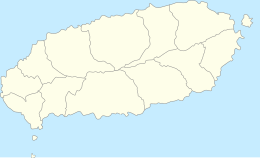Jeju Island
|
Native name: 제주도 Nickname: Sammu-samda-do = Island of no three kinds and many three kinds' |
|
|---|---|

Image of Jejudo
|
|
| Map of Jejudo | |
| Geography | |
| Location | East Asia |
| Archipelago | Jeju |
| Area | 1,848 km2 (714 sq mi) |
| Length | 73 km (45.4 mi) |
| Width | 31 km (19.3 mi) |
| Highest elevation | 1,950 m (6,400 ft) |
| Highest point | Hallasan |
| Administration | |
|
South Korea
|
|
| Special Autonomous Province | Jeju Special Autonomous Province |
| Largest settlement | Jeju City (pop. 408,364) |
| Demographics | |
| Population | 583,284 |
| Pop. density | 316 /km2 (818 /sq mi) |
| Ethnic groups | Korean |
| Jejudo | |
| Hangul | 제주도 |
|---|---|
| Hanja | 濟州島 |
| Revised Romanization | Jejudo |
| McCune–Reischauer | Chejudo |
Jejudo (also known as Jeju Island) is the largest island off the coast of the Korean Peninsula, and the main island of Jeju Province of South Korea. The island lies in the Korea Strait, southwest of South Jeolla Province. The island contains the natural World Heritage Site Jeju Volcanic Island and Lava Tubes. Jejudo has a moderate climate; even in winter, the temperature rarely falls below 0 °C (32 °F).
Historically, the island has been called by many different names including:
Island of no three kinds, and many three kindsThis means it was originally labeled the island of triple abundance: Wind, stones, and women, and then added to its reputation the fact it does not have beggars, thieves, or locked gates.
Before the Japanese annexation in 1910, the island was usually known as Quelpart to Europeans. The name apparently came from the first European ship to spot the island, the Dutch Quelpaert, which sighted it after being blown off course on its way to the Dutch trading base in Nagasaki, Japan, from Taiwan (then the Dutch colony of Formosa).
"According to Korean records, a fleet of seventy pirate craft attacked Quelpart Island and adjacent parts of the Korean peninsula in 1555."
When Korea was annexed by Japan in 1910, Jeju then became known as Saishū, which is the Japanese reading of the hanja for Jeju.
Before 2000, when the Seoul government established the official Revised Romanization of Korean, Jejudo was spelled Cheju-do. Almost all written references to the island before that use that spelling.
From April 3, 1948 to May 1949, the South Korean government conducted a brutal anticommunist campaign to suppress an attempted uprising on the island. The main cause for the rebellion was the election scheduled for May 10, 1948, designed by the United Nations Temporary Commission on Korea (UNTCOK) to create a new government for all of Korea. The elections were only planned for the south of the country, the half of the peninsula under UNTCOK control. Fearing that the elections would further reinforce division, guerrilla fighters for the South Korean Labor party (SKLP) reacted violently, attacking local police and rightist youth groups stationed on Jeju Island.
...
Wikipedia

